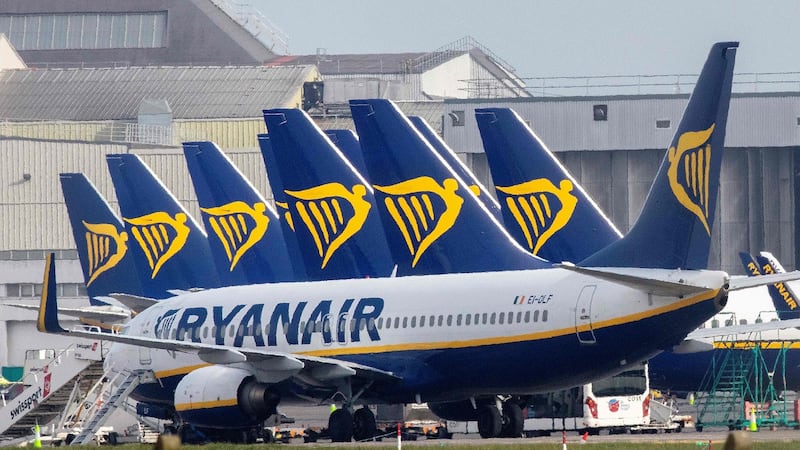Chief medical officer Dr Tony Holohan did not actually cancel Christmas this week, but it would be no surprise if airlines Aer Lingus and Ryanair thought he came close.
Addressing the Oireachtas Joint Committee on Transport and Communication Networks, Dr Holohan gave no real grounds for hoping that the Republic's Covid-19 travel restrictions could be eased on time for the festive season.
"International travel is not safe and movement of people around areas with high incidence of this disease, particularly in Europe and North America, in and out of this country, is not safe," he told the assembled TDs and senators.
Holohan was fielding questions from committee member and Fianna Fáil TD Cathal Crowe about the chances that Irish people living abroad could return home for Christmas without having to self-isolate for 14 days.
While many families are watching this carefully, airlines are likely to have been paying attention, too. From November 14th to December 13th, Ryanair will have no flights in or out of Cork, Knock and Shannon airports. Aer Lingus meanwhile will cut the frequency of its Cork-Heathrow service to three times a-week from daily, beginning this month. Schedules out of Dublin have also been impacted.

Band aid
For airlines, Christmas is normally a welcome boost in the middle of the traditionally slower part of the year. Eddie Wilson, chief executive of Ryanair Designated Activity Company, the group's biggest subsidiary, indicated to the same Oireachtas committee last week that it planned to restart some services from those regional airports in anticipation of demand ahead of the holiday.
This year, any festive boost to traffic would only really amount to putting a band aid on a severed artery. Airlines around the world have been bleeding cash since Covid-19 lockdowns first came into force in the spring. Ryanair Holdings this week reported that it lost €197 million after tax in the six months to the end of September, a period covering what should have been its most profitable period.
Instead, 99 per cent of its fleet was grounded for three months to the end of June. It restarted flying at the beginning of July, but with just 60 per cent of its 2019 capacity.
Charges of €240 million tied to unused fuel hedges and foreign exchange translation lifted losses for what was the first half of its financial year to €410 million. During the same period last year, the group earned a profit of €1.15 billion. Ryanair warned that losses in the second half could be worse and said it was not in a position to give any guidance for the outcome for the fiscal year as a whole, which ends on March 31st 2021.
Faster, cheaper tests that identify antigens are increasingly used for pre-departure screening in Europe
Days earlier, Aer Lingus owner, International Airlines Group, reported that it lost €1.3 billion in the three months to the end of September, which again should have been its peak season. Its total operating loss topped €1.9 billion.
Elsewhere in Europe, Budapest-based low-cost carrier, Wizz Air, announced on Thursday that it lost €145 million in the six months to September 30. On the same day, Germany's Lufthansa booked a net loss of €2 billion in the third quarter.
Ryanair had €4.5 billion in cash at the end of September, while IAG had €5 billion. Wizz Air’s reserves were €1.6 billion. The industry’s losses are huge, but not surprising in light of the fact that all European airlines were effectively grounded for three months while only partially recovering their businesses between July and September.
Eurocontrol, the umbrella body for the EU’s air traffic control authorities, this week said that the number of flights in the continent’s skies are likely to fall to 4.5 million this year from 11.4 million in 2019.
Vital support
The organisation's director general, Irishman Eamonn Brennan, said it was vital that states supported airlines in light of the current crisis. In a best-case scenario, Eurocontrol calculates that the industry will recover to 2019 levels in 2024, its worst case estimates that it could be 2029 before aviation gets back to normality.
Eurocontrol’s estimates are tied to vaccines, its best case assumes that effective inoculation against Covid-19 will be available by next summer, its worst factors in the possibility that no effective protection will emerge. Airlines are watching developments on this front carefully.
Ryanair's chief financial officer Neil Sorahan noted that up to three companies could seek regulators' approval for their vaccine candidates by the end of this year, with a further three likely to do the same in the opening quarter of 2021. US pharma giant Pfizer has said that it could apply this month for emergency approval for a vaccine that it is jointly developing with German player Biontech, making it the front runner.
However, most experts believe that it could take up to a year to vaccinate everyone. In the meantime, a key step to aviation’s recovery could be the EU’s “traffic-light” system for travel, which grades regions as green, orange or red, according to their infection rates, with green being the lowest and red the highest (see panel). The system focuses on regions rather than countries
This is due to come into effect from midnight on Sunday, November 8th. Originally, the EU Commission proposed that member states should allow free movement for travellers from green and orange regions, while replacing restrictions with tests for those from red zones. Last month, the bloc’s foreign ministers diluted this by allowing individual countries set their own rules for people arriving from orange and red zones.
Mild surprise
Up to this week, there were questions over what approach the Republic would take. Many in the industry feared that it would simply stick with existing rules, which require travellers from all EU countries not designated green to self-isolate and restrict their movements for 14 days.
So Eamon Ryan, Minister for Transport, caused mild surprise when he announced that the Government would go a step further than this. He said that from midnight on November 8th "the requirement for those arriving from orange locations can be waived, if they have a negative Covid-19 test result up to three days before arrival".
The 14-day restriction remains for those from red zones, but the Government has agreed that, “as soon as practicable, this can be waived following a negative result from an approved Covid-19 test taken five days after arrival”.
A “cross-departmental” group is due to give the Government a plan to establish approved test centres for international arrivals on November 10th. Mr Ryan told the Oireachtas joint committee on Transport that this would not interfere with the health service’s existing Covid-19 testing capacity.
The Government's approach signals some relaxation of its ultra-cautious view of air travel since the pandemic began
The flip side of this is that those travelling from the Republic to the rest of the EU will have to get tests confirming they do not have the virus before they leave here. State company DAA, responsible for Cork and Dublin airports, said several weeks ago that it has already lined up companies that can provide these facilities at both airports. Shannon Airport confirmed that it has made similar preparations.
Dalton Philips, DAA chief executive, told politicians last week that the company could have a facility up and running at Dublin Airport "within days" if the minister signs a statutory order waiving the need to get planning permission this. On Wednesday, Mr Ryan said that the Government would give DAA any assistance that it needed.
The Government favours what are called PCR tests, used by the health service to establish if someone with symptoms, or who has been in contact with a confirmed case, has the virus. These detect Covid-19’s DNA in somebody’ system, are lab based, and generally take at least 24 hours to produce a result.
Faster, cheaper tests that identify antigens, which are basically alarm signals sent out by the body's immune system when the virus attacks, are increasingly used for pre-departure screening in Europe, including by Aerporti di Roma, whose vice president, Ivan Bassatto, discussed this approach with Oireachtas transport committee members last week.
Reinstating services
Nevertheless, Mr Ryan said this week that for now, the best advice was antigen tests were not suitable for international travel, but he added “if that changes, we should change”. He was echoing what Holohan told politicians a day earlier, which was that the World Health Organization’s position was that these faster screening methods were not suitable for groups such as arriving passengers.
The Government’s approach signals some relaxation of its ultra-cautious view of air travel since the pandemic began. However, it falls short of what the aviation industry seeks, which is free movement for travellers from green and orange regions, combined with tests replacing restrictions for those from red zones.
At this point, there are few green or orange zones. A second Covid-19 wave has gripped Europe and the US, our main markets for trade, investment and tourism. Last week, the WHO said that 1.3 million new cases had been confirmed across the continent. Holohan noted that the average seven-day incidence of the virus in the EU and UK is 241 people out of every 100,000. “The vast majority of countries are red and getting redder,” he said.
Holohan did acknowledge that we were talking “six weeks out” when it came to Christmas, by which time the picture here and in Europe might have changed. In reality, Christmas is not the issue for aviation, it’s next year and beyond. Aer Lingus has begun selling flights for summer 2021, with the caveat that its plans assume some level of recovery.
Wilson told politicians last week that Ryanair was willing to look at reinstating services if the Government restored travel to green and orange regions. “In the meantime, however, the tide is going further out all the time and we are making decisions already for next summer,” he said.
EU traffic light system criteria
Countries are ranked green if the number of newly-notified cases per 100,000 in the past 14 days is lower than 25 and the test positive rate is below 4 per cent.
Countries are ranked orange if the number of newly-notified cases per 100,000 in the last 14 days is lower than 50 but the test positive rate is 4 per cent or higher, or, if the 14-day notification rate is between 25 and 150 and the test positive rate is below 4 per cent.
Countries are ranked red if the number of newly-notified cases per 100,000 in the last 14 days is 50 or higher and the test positive rate is 4 per cent or higher, or, if the number of newly-notified cases per 100,000 is higher than 150.



















